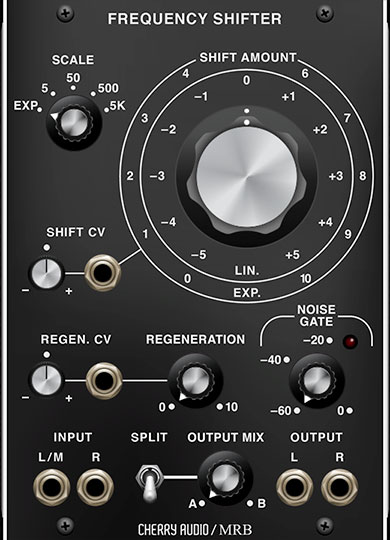The VM Rackmode Frequency Shifter is a super-accurate recreation of the vintage Bode Frequency Shifter. A frequency shifter is an audio modifier that "shifts" the entire frequency spectrum of the signal by a given amount. The VM Rackmode Frequency Shifter can shift the spectrum up or down by up to 5000 Hz, and the "downshifted" and "upshifted" signals are simultaneously available.
What Is A Frequency Shifter?
It's important to understand how a frequency shifter differs from a modern digital pitch shifter (aka, a "harmonizer"). A pitch shifter maintains harmonic relationships between tones and harmonics of the input signal (or at least, tries to). If you speak or sing into a pitch shifter, this means the voice sounds like a larger or smaller person, because the harmonic relationships are maintained. Conversely, these harmonic relationships are not maintained with frequency shifter, and as a result, processed audio starts to sound unnatural beyond very small amounts of shift. Small amounts of shift are useful for phase-y types of sounds (particularly when the Regeneration knob is up). Large amounts generally create harmonically rich and clangorous metallic timbres.
In layman-est of layman's terms, even if you don't 100% understand what's going on under the hood, the frequency shifter can make a whole lot of incredible sounds, and it's very easy to use.
Inputs, Outputs, and Controls
Scale selector - The Scale knob is a coarse control for overall shift range, similar to the octave switches in a synth oscillator. The Scale selector positions are as follows:
Exponential- The Shift Amount knob scale is exponential, with frequency shift amounts represented in the outer concentric circle. In exponential mode, the shift range is 2 Hz to 2 kHz, from full counterclockwise to full clockwise.
5/50/500/5k- The Shift Amount knob scale is linear, with frequency shift amounts represented in the inner concentric circle. Shift amount starts at zero (center position) and goes down or up when the Amount Of Shift knob is turned counterclockwise or clockwise, respectively. The maximum setting in either direction is determined by the current Scale range.
Shift Amount- This is the main control for setting the amount of shift. Center position is no shift, and turning the knob left or right introduces negative or positive shift, respectively.
Shift CV jack and attenuator- Allows positive or negative CV mod of the Shift Amount setting.
Regeneration CV jack and attenuator- Allows positive or negative CV mod of the Regeneration setting, explained below.
Regeneration- This is a feedback control that sends the output back to the input at an amount determined by the knob setting. It really opens up a lot of sonic possibilities, and with subtle amounts of shift, it's useful for phaser-like sounds.
Noise Gate Threshold and LED- Allows fine-tuning of input level to prevent bleedthrough of the unprocessed signal to the processed signal. Thanks to the wonder of modern computers, bleedthrough is a far less of a concern than it was with analog hardware frequency shifters, but it's included to accurately replicate the original.
Turning the knob clockwise sets the input threshold higher until the input signal completely disappears. The LED illuminates to indicate signal is passing.
Inputs and Outputs
The VM Rackmode Frequency Shifter can be used with mono or stereo signals.
Input jacks- Plug incoming signals in here. Use the L/M input if the signal is mono.
Output Mix- The VM Rackmode Frequency Shifter outputs "upshifted"(A) and "downshifted" (B) signals simultaneously; Mix- Sets the mix level between downshifted (A) and upshifted (B) signal.
Output jacks- The frequency shifted output.
